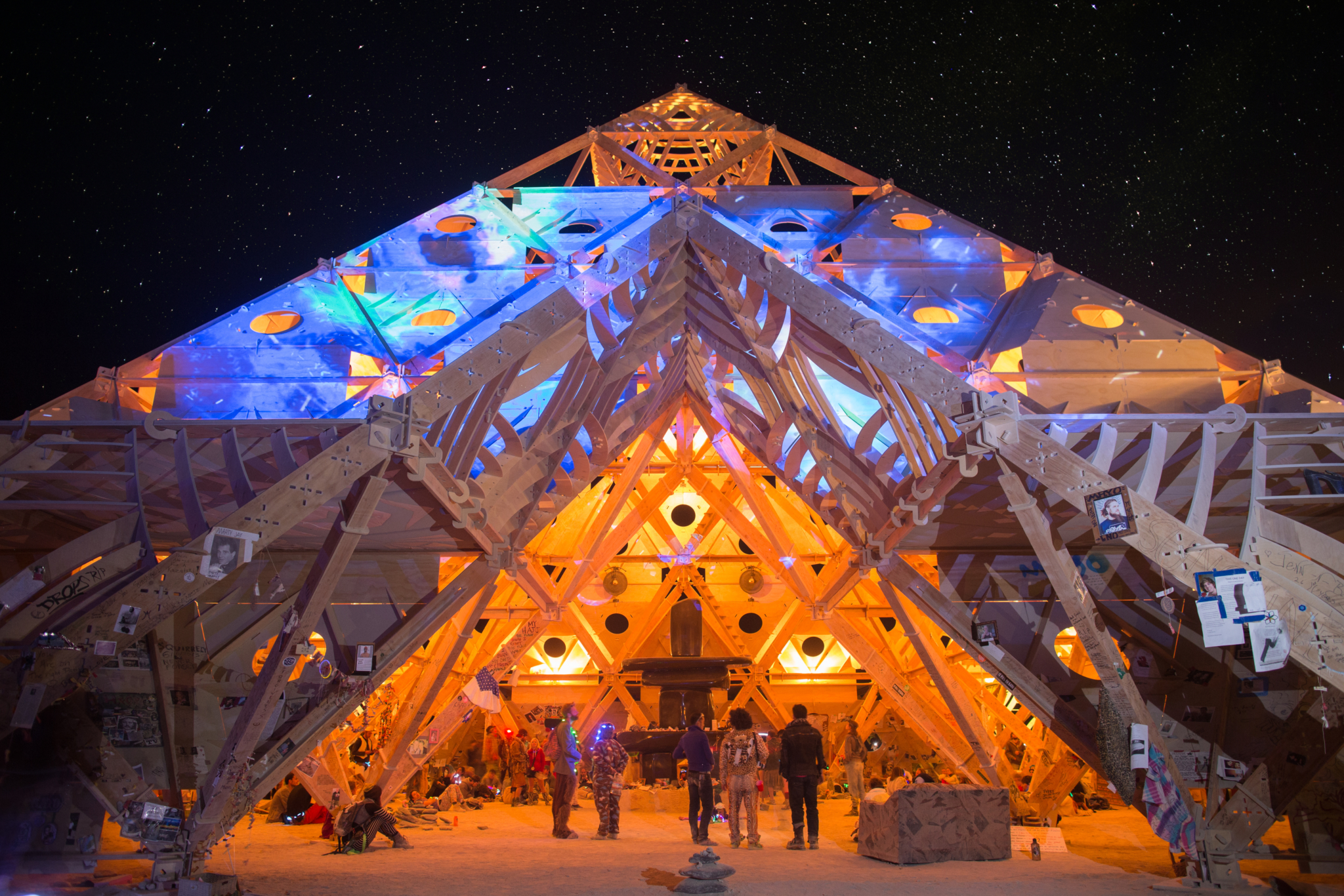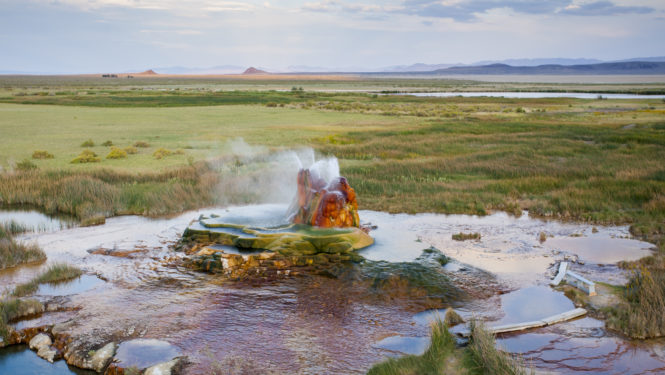Greetings, Earthlings! Since we only currently have one planet available, the Burning Man principle of Leaving No Trace is not just an ideal — it’s a matter of survival. Burning Man is a big activity, which carries with it a big responsibility. We all have to practice Leaving No Trace, and it’s our shared responsibility to minimize our impact, not just for the sustainability of the event and the playa, but for the beautiful blue and green planet on which the event is currently held.
Burning Man has been in compliance with environmental regulations under the National Environmental Policy Act virtually every year since our event has been held and permitted on public land. This includes undergoing a series of Environmental Assessments and followup amendments over the years. We are currently developing a 10-year Environmental Impact Statement with the Bureau of Land Management that will analyze the potential environmental impacts of Black Rock City on the playa and nearby communities. The analysis includes air quality, traffic, noise, night skies, cultural resources, and socioeconomic impact. Public outreach meetings were held in Gerlach, Lovelock, and Reno in December, 2017; over 75 letters and comments were received as part of that process. The draft EIS is expected later this year, and the final report will be done in 2019. We look forward to understanding the impact better ourselves, and to sharing the findings with the community.
Fly Ranch, our newest program, is setting a course for an environmentally sustainable Burning Man beyond Black Rock City. Not only is Burning Man learning to be stewards of our own land (and the land’s many non-human Earthling residents), we’re using this opportunity to experiment with clean technologies like composting toilets, renewable power generation, and techniques for sustainably tapping local water sources.
Down the road in BRC, though, environmental efforts go back to the early years. The first trash fence went up in 1995. Leaving No Trace was formally ratified and Earth Guardians formed in 1998. In the following decade, when the scale of the event increased significantly, Burning Man needed a new plan to help decrease our collective environmental impact. Playa Restoration and the hugely popular MOOP Map came online in 2006. And then in 2007, with the Green Man theme, more Burners began to formulate a response to the looming threat of climate change caused by invisible MOOP, namely carbon emissions.

Carbon Emissions: Invisible MOOP
There’s no way around the fact that Black Rock City has a substantial carbon footprint. Tens of thousands of people camp on site each year and many thousands use generators to supply power for air conditioning, sound, and refrigeration. We have an impact beyond the playa as well, driving and flying to Nevada and to the event site, some of us hauling literally tons of art and equipment with us. Based on the analysis we conducted in 2006, Black Rock City’s carbon emissions impact today is estimated to be 91 million pounds for the seven days of the event, or 1,400 pounds per person. For perspective, a round trip flight from San Francisco to Washington D.C. emits about 1,474 pounds of CO2, and the average American’s weekly carbon footprint is 846 pounds.
Burning Man Project expressed a renewed desire for the organization and the community to work together to address the carbon challenge in December 2015. While we had no illusions of Black Rock City becoming carbon neutral in the short-term, we suggested that we all look for ways to make to reduce emissions and make our impact “carbon light.” There’s now a working group at BMHQ shepherding this issue forward. All departments, including Office Operations, Nevada Properties, Black Rock City, and Fly Ranch, are factoring this challenge into their operations plans. In the run-up to the 2017 event, we added Greening Your Burn tips to the Jackrabbit Speaks newsletter in addition to our annual issue devoted entirely to the subject, and we promoted a participant-created carbon offsetting program, which we’re expanding this year. Is there more we can do? Yes, and we’ll keep you posted on our progress.
All that said, the vast majority of air contaminant emissions associated with Burning Man come from transportation to and from the event — all those cars and trucks you wish would disappear from Gate Road. Facing this challenge head on, we started Burner Express Bus in 2015 and Burner Express Air in 2016. Together these programs moved over 9,000 people to and from Black Rock City in 2017 and removed approximately 3,740 vehicles from the roadways and playa. We have even incentivized this rideshare program by making a number of Burning Man tickets available exclusively to BXB and BXA passengers.
In order to encourage carpooling, we implemented a vehicle pass requirement in 2014 for all traffic entering the event site. Now every vehicle must purchase and display the appropriate sticker to gain entrance to Black Rock City. This program has been successful both in terms of incentivizing ride shares and helping us understand our cumulative impact to roadways and air emissions.
Of course, many of us emit greenhouse gases from our mutant vehicles, generators, and art burns on playa, not to mention all that shopping for stuff. The Greening Your Burn website section has helpful tips for reducing these environmental impacts. And that’s not just about CO2 — it’s MOOP reduction and clean-up, recycling, composting, and burning cleaner materials.
By the way, for the artists out there, burning stuff is cool, but planning a life after playa for your art project is also cool, perhaps even cooler! Either way, making art out of reclaimed or renewable materials is definitely ultra-cool. Last year’s Temple was made of reclaimed wood that had been killed by bugs and posed a fire risk either way. If a piece as large and complex as the Temple can do this, we believe other projects can follow suit! For five years, the folks behind the 2013 Temple have run a campaign called Art for Trees that has planted 30,000 trees to date. Big appreciation to these forward-thinking artists for setting the pace.

Innovation at Black Rock Labs
In our 2015 Journal post, we described the beginnings of a joint Burning Man Project/Black Rock Solar effort to come up with a new model to measure Black Rock City’s carbon footprint based on the 2012 Environmental Assessment. Now that we’re involved in a new 10-year Environmental Impact Statement, the updated carbon inventory is on temporary hold while the analysis on the EIS takes place. With the EIS, we’ll have a better understanding of Burning Man’s current and projected environmental impact in multiple areas including greenhouse gas emissions.
Black Rock Solar, meanwhile, has declared victory and pivoted into a new entity: Black Rock Labs. Their goal is to be the incubator for, like, 1,000 new Black Rock Solars — new clean-tech initiatives born in our community — supporting Black Rock City, Burning Man Regional Events and the world at large. Their new website is live; check it out and see what they’re up to. Black Rock Labs wants to be for clean-tech projects what Black Rock City is for art projects. Do you have a clean-tech project you want Black Rock Labs and Burning Man to know about, or a vision for one you’d like to see? Let them know via the forms on their homepage.
While carbon offsets are no substitute for actually reducing emissions, our community has made a promising start offering ways for all participants to reduce carbon emissions elsewhere to compensate for the ones we’re creating on playa and on the way to Black Rock City. Last year, IDEATE and Black Rock Labs created a program for Burners to buy carbon offsets from C-Quest Capital, and it offset 877 Burners’ worth of CO2. We’re thrilled they’re bringing it back for 2018 with a lot more lead time, and we encourage you to participate in this program (here’s a downloadable PDF with more info about the 2018 program).
We look forward to advancing this conversation and exploring new ideas for decreasing our environmental impacts, reducing our carbon footprint, and improving environmental sustainability across the Burning Man community. Do you have an idea? A story to share? An innovation that could benefit Black Rock City and beyond? If so we encourage you to submit it here. We look forward to learning from you and working with you on this important challenge.
Top photo by George Post


Unfortunately one of the seemingly innocent fun parts; using helium is the last we do with it.
After escaping into the air we never get it back.
Even more urgent we do not leave any other trace.
Report comment
In 2017 my camp worried because , after years of having grid power , we were off the grid. We debated bringing a generator but in the end did without.
Instead we brought some solar powered spot lights which we set up in our shade structure and which supplied plenty of light for our activities. A sign I made was also lit by solar spots and rope lights and stayed lit all night. Solar rope lights placed at our road frontage defined our space , and a solar powered decorative fountain provided a hint of water in the desert.
So, rethink if you really need to bring that honking big, noisy, polluting generator this year.
Oh, by the way,
Leaving crushed empty beer cans in the urinal in the porta potties is WAY UNKOOL!!!!
Report comment
you think maybe this attitude could be extended to the Walmart parking lot, and the other places burners pick up supplies?
I was horrified and disgusted.
Merry
Report comment
I’ve been to BM last year and – to be honest – have never seen such a huge mass of never-use-again plastic china LED thrash which will be just thrown away after one BM. That environmental “leave no thrash” thing is in my opinion more of a window washing. You better should try to reduce the use of one-time-LED china trash instead of the “leave-no-trace” policy – because the “trace” is seen after every BM in the huge amounts of thrash on the way out to the next city. Just by moving thrash from one place to another doesn’t reduce it!
Better offer some kind of recycling system, reduce the use of LED, reduce the use of plastic bottles etc.
Report comment
Interesting. The LEDs came into being because before that people were using glow sticks to keep from getting run over at night. It was felt those glow sticks were too moopy. Burners need some sort of light on the playa for safety. What would you suggest as an environmentally sound way to keep from getting squished.
Report comment
Instead we’ve brought some solar powered spot lights which we set up in our shade structure and which supplied plenty of light for our activities. A sign I made was also lit by solar spots and rope lights and stayed lit all night. Solar rope lights placed at our road frontage defined our space , and a solar powered decorative fountain provided a hint of water in the desert.
Report comment
What about the smog contribution of the burning materials?
Report comment
Comments are closed.